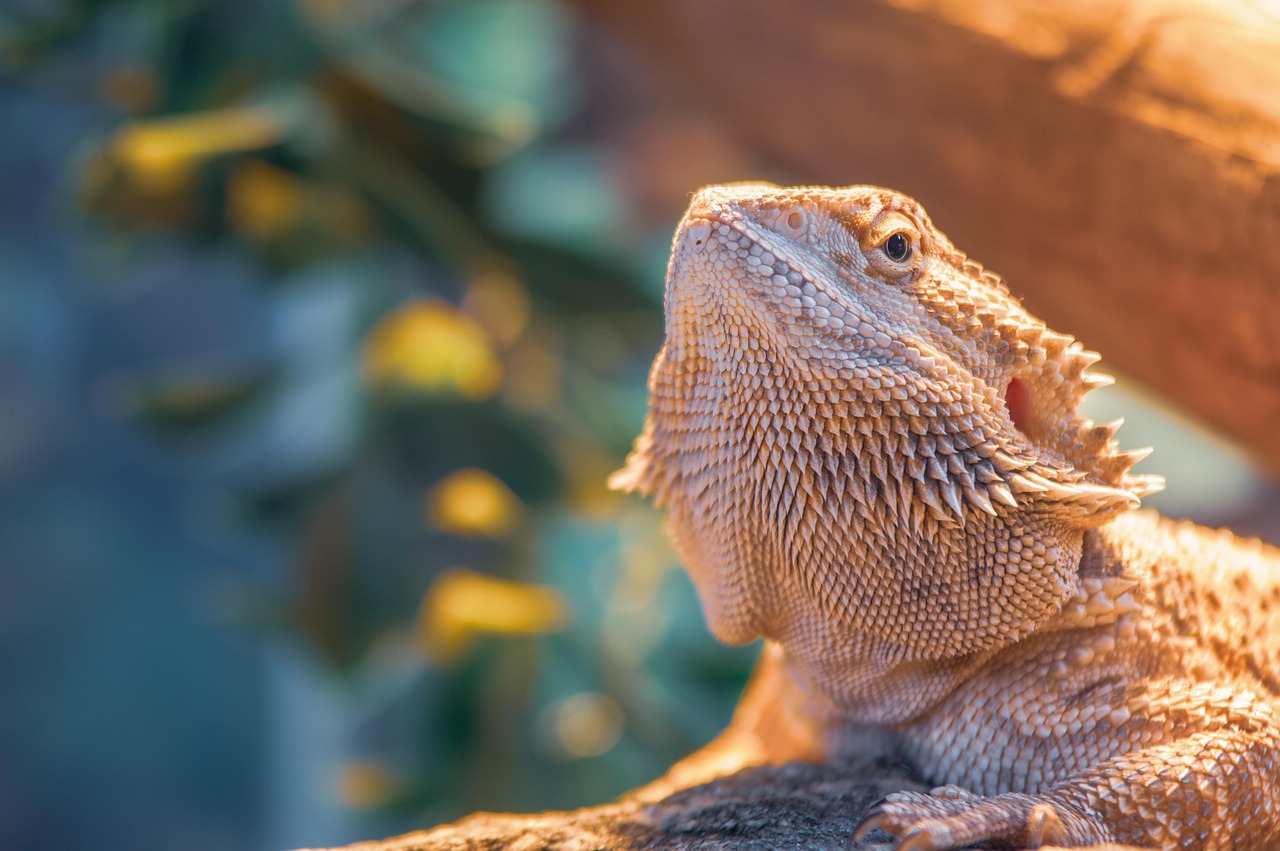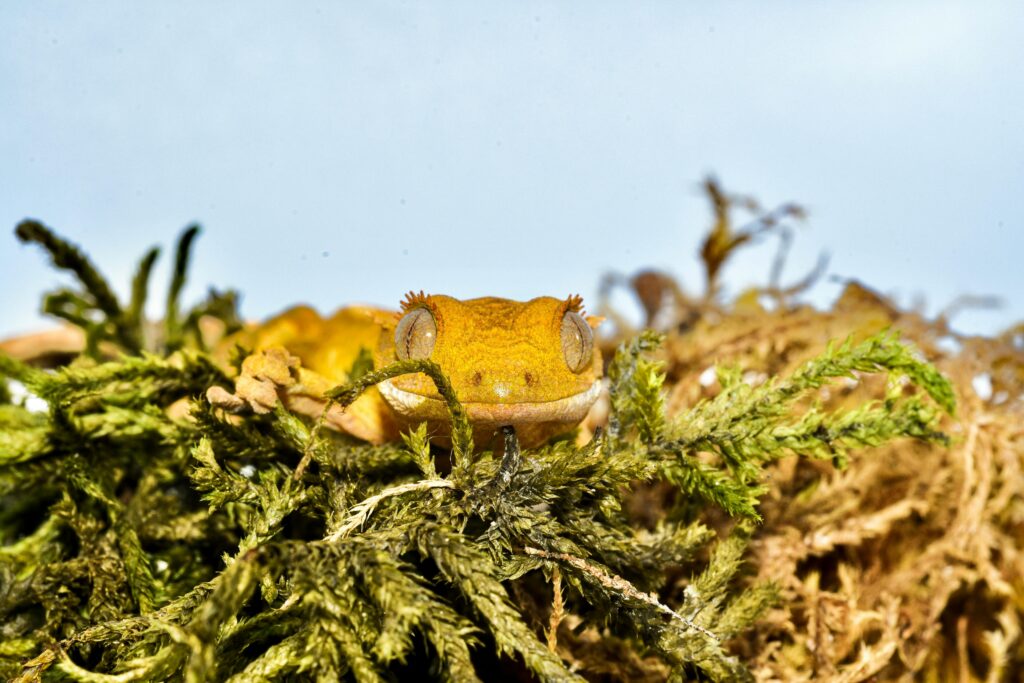Introduction:
Why Proper Bearded Dragon Care Matters
Bearded dragons are among the most popular reptile pets and for good reason. Their docile temperament, unique behaviors, and manageable size make them ideal for both beginners and experienced reptile keepers. However, their long-term health and happiness depend on proper care.
This bearded dragon care guide provides a science-backed, vet-approved approach to raising a thriving dragon. Whether you’re setting up your first enclosure or refining your husbandry skills, this guide covers:
✅ Optimal habitat setup (lighting, heating, and tank requirements)
✅ Nutritional needs (live feeders, veggies, and supplements)
✅ Behavior & handling tips (taming, socialization, and stress signs)
✅ Health prevention (common illnesses and vet care)
By the end, you’ll have the confidence to give your bearded dragon the best life possible. Let’s dive in!
1. Bearded Dragon Basics: Species Overview
Scientific Name: Pogona vitticeps
Origin: Arid regions of Australia
Average Lifespan: 8–12 years (up to 15 with exceptional care)
Size: 18–24 inches (males larger than females)
Popular Morphs & Colors
- Classic/Normal: Wild-type coloring (tan, brown, hints of yellow).
- Leatherback: Smoother scales due to reduced spikes.
- Hypomelanistic: Reduced dark pigment (lighter appearance).
- Translucent: Semi-transparent scales, often with blue eyelids.
Pro Tip: Avoid “silky” or “microscale” morphs—they often have genetic health issues.
2. Setting Up the Perfect Bearded Dragon Enclosure

Best Enclosure Types:
- Front-opening PVC terrariums (retain heat/humidity better than glass).
- Custom-built wooden vivariums (ideal for advanced keepers).
Lighting & Heating: A Non-Negotiable Trio
- Basking Spot: 95–110°F (use a halogen bulb or deep heat projector).
- UVB Lighting: T5 HO 10.0 or 12% linear tube (spanning ½ the enclosure).
- Without UVB, dragons develop Metabolic Bone Disease (MBD).
- Cool Side: 75–85°F (allows thermoregulation).
Nighttime Heat: Only if temps drop below 65°F (use a ceramic heat emitter—no colored bulbs).
And is a heat mat safe for Bearded Dragon
Substrate & Decor: Safety First
- Safe Options:
- Slate tile
- Reptile carpet
- Paper towels (best for quarantined/new dragons)
- Avoid: Loose sand (risk of impaction), walnut shells, or cedar chips.
Enrichment Ideas:
- Cork bark tunnels
- Sturdy branches for climbing
- A “dig box” with organic topsoil/sand mix (for adults)
3. Bearded Dragon Diet: From Bugs to Greens
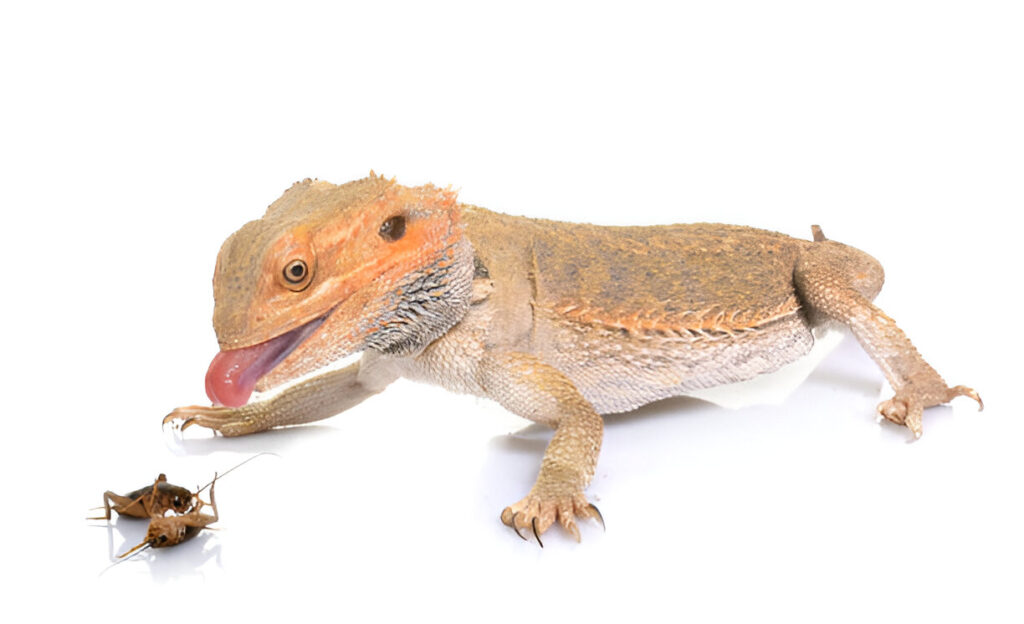
Live Feeders (Protein Sources)
| Feeder | Nutritional Value | Feeding Frequency |
|---|---|---|
| Dubia roaches | High protein, low fat | Staple for all ages |
| Black soldier fly larvae | High calcium | Great for juveniles |
| Crickets | Moderate protein | Gut-load before feeding |
| Hornworms | Hydrating (low protein) | Occasional treat |
Rule of Thumb:
- Babies: 80% insects, 20% veggies (feed 3x/day).
- Adults: 20% insects, 80% veggies (feed 1x/day).
Vegetables & Fruits: The Salad Bar
Plant matter must be introduced early, despite the fact that babies will ignore it initially. Variety prevents nutritional deficiency.
Every-Day Staples (Provide Daily)
- Collard Greens: High in calcium, vitamin A, and K
- Mustard Greens: High in fiber and antioxidants
- Dandelion Greens: Foraged (don’t harvest in areas sprayed with pesticides)
- Endive: Crisp texture dragons devour
- Escarole: Mild flavor, extremely nutritious
Less Frequent Vegetables (2-3 times per week)
- Butternut Squash: Shredded or cubed (high in vitamin A)
- Bell Peppers: Any color (cut out seeds)
- Snap Peas: Chopped (with pods)
- Green Beans: Lightly steamed for simpler digestion
- Zucchini: Perfect moisture content
Fruits (Limit to 10% of Diet)
- Blueberries: Antioxidant superfood
- Papaya: Digestive enzyme helper
- Mango: Vitamin A and C packed
- Figs: Calcium source
- Melon: Water-rich snack
Foods to Avoid:
- Iceberg lettuce (nutritionally meaningless)
- Spinach (calcium binder)
- Avocado (toxic)
- Rhubarb (toxic)
- Citrus fruits (upset digestive system)
Supplements: Preventing Deficiencies
Even with optimal feeding, supplements are still necessary in captivity.
Calcium Supplementation
- With D3: 3-4 times a week (if UVB is weak or through screen)
- Without D3: 5-6 times a week (with appropriate UVB exposure)
- Application: Lightly dust insects with calcium powder just before feeding
Multivitamins
- Choose reptile-specific products
- Add beta-carotene (not pre-formed vitamin A)
- How often: 1-2 times a week
- Do not combine with calcium supplements at same meal
Probiotics
- Beneficial for:
- Dragons on antibiotic treatment
- Stress periods (relocation, brumation)
- Stimulation of appetite
- May be mixed with food 1-2 times weekly
Hydration Techniques
Bearded dragons receive a majority of their hydration through diet, but other techniques aid:
- Misting:
- Spray greens lightly before feeding
- Mist dragon’s nose 2-3 times weekly
- Helps with shedding
2. Bathing:
- 2-3 times weekly for 10-15 minutes
- Lukewarm water (90-100°F)
- Supervised to prevent drowning
3. Water Dishes:
- Shallow dish (daily disinfected)
- Some dragons will soak
- Add rocks to prevent drowning danger
Special Feeding Considerations
For Picky Eaters:
- Try bee pollen as appetite stimulant
- Hand-feed favorite treats
- Mix greens with edible flowers
For Overweight Dragons:
- Include fiber-rich greens
- Restrict fatty feeders (waxworms, superworms)
- Encourage exercise through feeding enrichment
For breeding females:
- Raise calcium supplementation
- Increase protein intake
- Add extra high-fat feeders
Remember to adjust portions based on your individual dragon’s activity level and body condition. Weighing on a regular basis allows tracking of dietary adequacy.
4. Handling & Behavior: Bonding With Your Dragon
Bearded dragons are amiable animals, but trust develops through time and patience. Getting to know their body language and having good interaction will help you build a friendly relationship with your pet.
Taming a Skittish Dragon
If your bearded dragon is new or fearful, follow these steps to help them get used to handling:
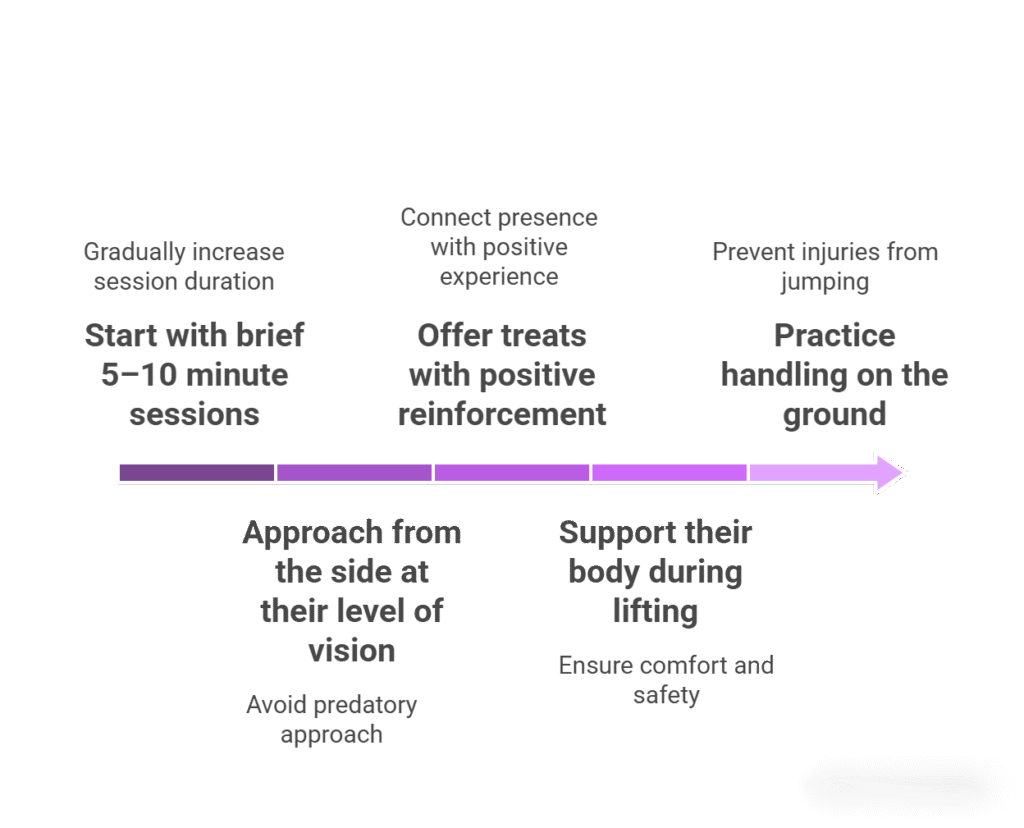
Pro Tip: If your dragon puffs up and darkens their beard, step back and try again later. Forcing it will contribute to stress.
Bearded Dragon Behavior
Bearded dragons communicate through body language. It’s a good idea to know their signals so you can respond accordingly:
Common Behaviors & What They Mean
- Arm Waving – A slow, circular motion of one arm is a submissive gesture (“I’m not a threat”). Common in juveniles or when meeting other dragons.
- Head Bobbing – Fast up-and-down movements signal dominance (males do this frequently) or territorial behavior.
- Beard Flaring – The beard turns black when it is stressed, threatened, or when breeding is being exhibited. Check for other signs of sickness if this is extremely frequent.
- Glass Surfing – Frantic scratching on tank walls usually indicates that the animal is stressed because of:
- Enclosure too small
- Incorrect temperatures
- Seeing their reflection
- Restlessness during breeding season
- Excessive Hiding – While hiding sometimes is to be expected, chronic avoidance may indicate:
- Parasites or illness
- Bad temperatures (too cold)
- Stress from loud noises or over-handling
Signs of a Happy Dragon
✅ Relaxed body posture (not flattened or puffed out)
✅ Normal alertness and appetite
✅ Basks readily with half-closed eyes
✅ Comes willingly to the front of the enclosure
Handling Do’s and Don’ts
Do:
✔ Wash hands before and after handling (prevallsalmonella risk).
✔ Keep sessions brief to start with (5–15 minutes).
✔ Let them walk from hand to hand instead of holding on tightly.
✔ Handle in a quiet, calm environment.
Don’t:
✖ Wake a sleeping dragon abruptly.
✖ Hold them upside down (stressful).
✖ Allow unsupervised time with other pets (cats/dogs may trigger panic).
✖ Handle right after eating (wait 1–2 hours to prevent regurgitation).
Socialization Tips
Although bearded dragons are hand-tolerant, they do not require companionship (and should never be kept together). To keep them stimulated:
- Whisper when going up to their tank.
- Provide enrichment such as climbing perches or dig boxes.
- Alternate handling times—some dragons like mornings, others nights.
Note: Every dragon has its own personality. Some prefer to be picked up often, while others prefer to be left alone. Respect their wishes for a stress-free pet.
Troubleshooting Behavior Problems
| Problem | Potential Cause | Solution |
|---|---|---|
| Aggression (bites/hisses) | Stress due to fear, pain, or territorial issues | Move slowly; inspect for sickness |
| Lethargy | Cold temperatures, brumation, or illness | Monitor temps; vet appointment if ongoing |
| Refusing food | Stress, parasites, or dieting improperly | Inspect husbandry; fecal exam |
When to Call a Vet:
- Abnormal behavior for more than 48 hours
- Signs of pain (twitching, limping)
- Prolonged lack of appetite (especially in juveniles)
By observing and respecting your dragon’s cues, you’ll build a trusting relationship that makes handling enjoyable for both of you.
5. Health & Wellness: Preventing Common Issues
| Condition | Symptoms | Action Steps |
|---|---|---|
| Metabolic Bone Disease (MBD) | Limp limbs, jaw softening | Vet ASAP—increase UVB/calcium |
| Impaction | Lethargy, bloated belly | Warm baths, vet if no poop in 48h |
| Parasites | Weight loss, runny stool | Fecal test at reptile vet |
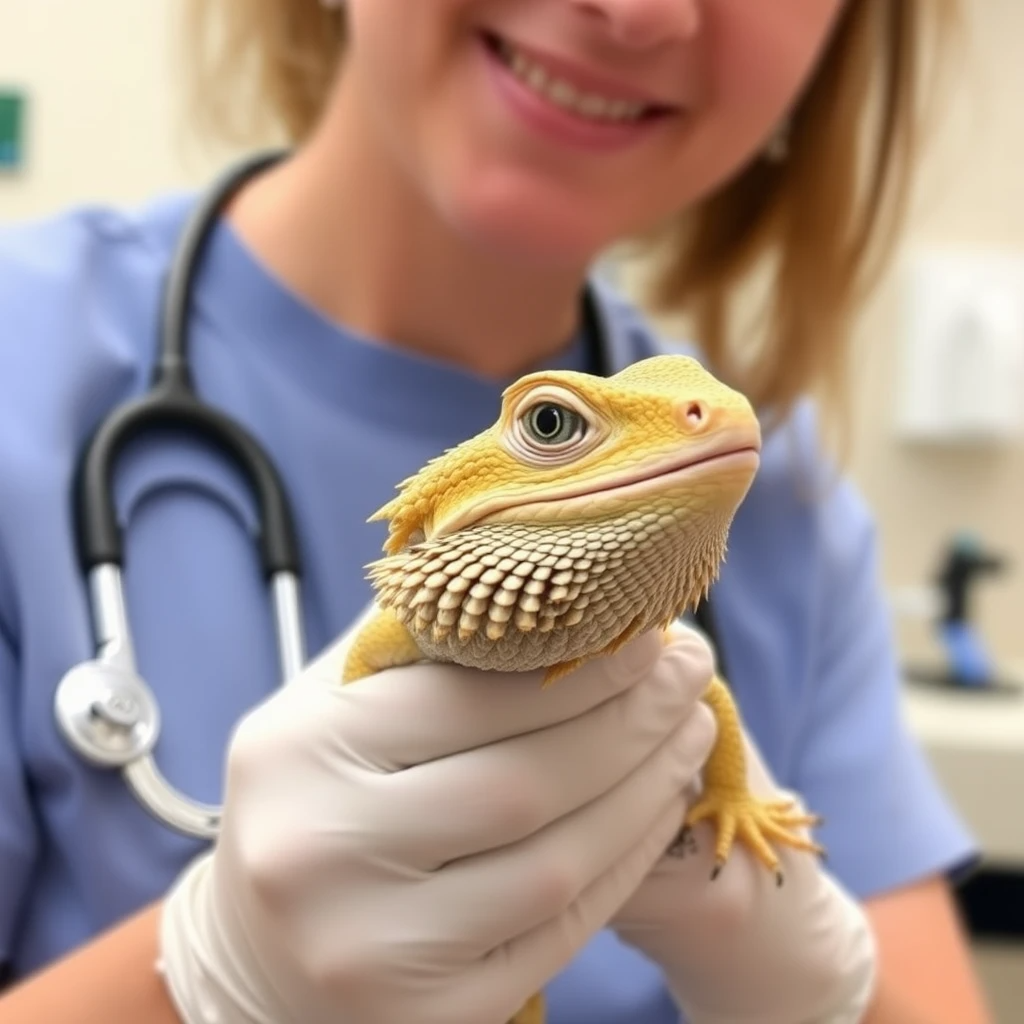
Vet Visits: Annual check-ups + fecal exams (even if no symptoms).
Conclusion: Your Roadmap to Exceptional Bearded Dragon Care
Raising a bearded dragon is incredibly rewarding when done right. This bearded dragon care guide has equipped you with:
✔ The ideal habitat setup (lighting, heating, and tank specs).
✔ A balanced diet plan (live feeders, greens, and supplements).
✔ Pro handling tips to build trust.
✔ Health prevention strategies to avoid common issues.
Your dragon’s health starts with you. With this knowledge, you’re ready to provide a long, vibrant life for your scaly friend!

Jalea Stevens, a veterinary student with a heart for animal health, education, and community. As I work toward earning my DVM, I’m especially passionate about making veterinary knowledge more accessible to pet owners and animal enthusiasts. Throughout my journey, I discovered one of my many missions is to bridge the gap between clinical knowledge and everyday pet care empowering others to make informed decisions for the animals they love.

